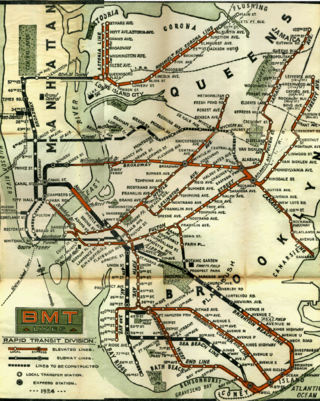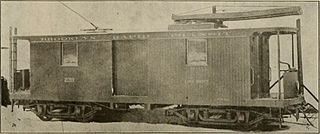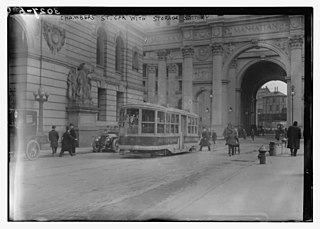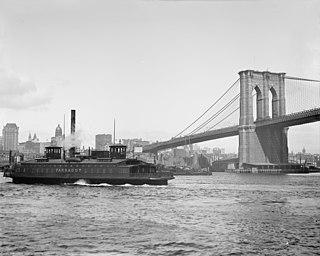Related Research Articles

South Ferry is at the southern tip of Manhattan in New York City and is the embarkation point for ferries to Staten Island and Governors Island. Battery Park, abutting South Ferry on the west, has docking areas for ferries to Liberty Island and Ellis Island. Its name is derived from the more southerly route of service of the historical South Ferry Company in comparison to the Fulton Ferry.

The Interborough Rapid Transit Company (IRT) was the private operator of New York City's original underground subway line that opened in 1904, as well as earlier elevated railways and additional rapid transit lines in New York City. The IRT was purchased by the city in June 1940, along with the younger BMT and IND systems, to form the modern New York City Subway. The former IRT lines are now the A Division or IRT Division of the Subway.

The BMT Lexington Avenue Line was the first standard elevated railway in Brooklyn, New York, operated in its later days by the Brooklyn Rapid Transit Company, the Brooklyn–Manhattan Transit Corporation, and then the City of New York.

The Brooklyn City Railroad (BCRR) was the oldest and one of the largest operators of streetcars in the City of Brooklyn, New York, continuing in that role when Brooklyn became a borough of New York City in 1898.
Starting in 1899, the Brooklyn Rapid Transit Company and Brooklyn–Manhattan Transit Corporation operated rapid transit lines in New York City — at first only elevated railways and later also subways.

The Atlantic Avenue Railroad was a company in the U.S. state of New York, with a main line connecting downtown Brooklyn with Jamaica along Atlantic Avenue. It was largely a streetcar company that operated its own trains, but the Long Island Rail Road operated both streetcars and steam trains over its main line. It later became part of the Nassau Electric Railroad, but is now divided between the active Atlantic Branch of the LIRR and the unused Cobble Hill Tunnel, which is preserved in its original state, albeit without service tracks.

The Brooklyn Heights Railroad was a street railway company in the U.S. state of New York. It leased and operated the streetcar lines of the Brooklyn Rapid Transit Company, but started out with the Montague Street Line, a short cable car line connecting the Wall Street Ferry with downtown Brooklyn along Montague Street. Eliphalet Williams Bliss owned the railroad.

The Bergen Street Line is a public transit line in Brooklyn, New York City, running westbound mostly along Bergen Street, as well as eastbound on Dean Street, between Downtown Brooklyn and Ocean Hill. Originally a streetcar line, it is now the B65 bus route, operated by the New York City Transit Authority. The B65 is based out of the East New York Depot in East New York, Brooklyn.

The Nassau Electric Railroad was an electric street railway company in the U.S. state of New York. The company operated throughout the borough of Brooklyn, as well as over the Brooklyn Bridge and Williamsburg Bridge into Manhattan.
The B69 is a bus route that constitutes a public transit line operating in Brooklyn, New York City, running along 7th Avenue and Vanderbilt Avenue between Kensington and Dumbo. The B69 is operated by the MTA New York City Transit Authority. Its precursor was a streetcar line that began operation in 1869, and was known as the Vanderbilt Avenue Line. The route became a bus line in 1950.

The B45 is a bus route that constitutes a public transit line operating in Brooklyn, New York City, mainly along Atlantic Avenue, Washington Avenue, Sterling Place, and St. Johns Place between Downtown Brooklyn and Crown Heights. It is operated by the MTA New York City Transit Authority. Its precursor was a streetcar line that began operation in 1877, and was known as the St. Johns Place Line. The route became a bus line in 1947.

South Ferry was a ferry landing on the Brooklyn side of the East River, at the foot of Atlantic Avenue below the Brooklyn Heights neighborhood. It is now Piers 5 and 6 in Brooklyn Bridge Park.

The New York Railways Company operated street railways in Manhattan, New York City, between 1911 and 1925. The company went into receivership in 1919 and control was passed to the New York Railways Corporation in 1925 after which all of its remaining lines were replaced with bus routes.

The Fifth Avenue Line, also called the Fifth Avenue Elevated or Fifth Avenue–Bay Ridge Line, was an elevated rail line in Brooklyn, New York City, United States. It ran above Hudson Avenue, Flatbush Avenue, Fifth Avenue, 38th Street, and Third Avenue from Downtown Brooklyn south to Bay Ridge. The portion on Third Avenue was called the Third Avenue Elevated to distinguish service from the elevated BMT West End Line; it was separate from the elevated IRT Third Avenue Line in Manhattan and the Bronx.
The Union Avenue Line was a public transit line in Brooklyn, New York City, United States, running mostly along Myrtle Avenue, Knickerbocker Avenue, Flushing Avenue, Throop Avenue, and Union Avenue from Ridgewood, Queens northwest to Greenpoint, Brooklyn.
The Adams Street and Boerum Place Line was a public transit line in Downtown Brooklyn, New York City, United States, running along Boerum Place and Adams Street. It served as access for the Atlantic Avenue Railroad to the City Hall area.
The Hicks Street Line was a public transit line in Brooklyn, New York City, United States, running from the Ninth Avenue Depot at Greenwood Cemetery to the Brooklyn Bridge.

The Fulton Ferry was the first steam ferry route connecting Manhattan and Brooklyn, New York City, United States, joining Fulton Street, Manhattan, and Fulton Street, Brooklyn, across the East River. It revolutionized travel between the then City of New York on Manhattan Island and the Village of Brooklyn and the rest of Long Island. Robert Fulton's steam Fulton Ferry Company in 1814 established his name on the ferry service. After the Brooklyn Bridge was built, ridership declined, and the ferry ceased operation on January 19, 1924. NYC Ferry now serves a very similar route.
References
- ↑ "Brooklyn Ferries". Brooklyn Daily Eagle . Brooklyn, NY. 18 July 1870. p. 2.
- 1 2 3 Cudahy, Brian J. (1990). Over and Back: The History of Ferryboats in New York Harbor. Fordham Univ Press. ISBN 9780823212453.